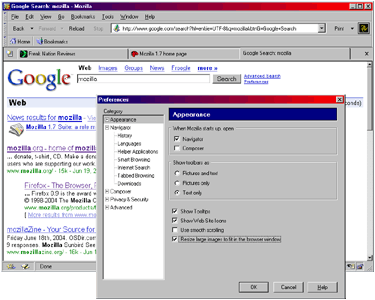
 |
Review: Mozilla 1.7The Lizard Keeps On Roaring |
Software: Mozilla 1.7
License: Open Source (Mozilla Public License)
Platforms: Win32, MacOS X, Linux
System Req’s:
(x86) Pentium 233 MHz, 64 MB RAM, 52 MB HD space;
(Mac) PowerPC 604e 266 MHz, G3 or better, 64 MB RAM, 72 MB HD space
Freak Nation Rating: ![]()
![]()
![]()
![]()
Available From: www.mozilla.org
The Mozilla Project has just released the newest incarnation of its flagship browser suite, Mozilla 1.7. Building on the solid core that’s underlain the various Gecko-engine browsers for the past couple of years, this new release is mostly an incremental improvement; it doesn’t even claim to be a radical departure from version 1.6. But, as increments go, this is a pretty big one.
The developers claim they’ve made various incremental speed improvements over Mozilla 1.6 (scroll down to “Under the Hood”), but the page loads, in particular, feel a lot faster than the claimed 9 percent. Of course, load times are subject to a host of factors, ranging from the load on the remote server to the load on your own machine, to the congestion of the Internet between the two. But my casual sense of the new browser’s speed was, “Hey, I actually notice that it’s faster!” Which is an impressive achievement — you normally notice such things only with a stopwatch and a real testing facility.
As with previous versions of Mozilla, the installation is a snap: no reboots needed, no spyware involved, no nasty EULA (unless you consider the Mozilla Public License to be “nasty”), and a pretty straightforward wizard that (on Windows) roughly matches the steps in a standard InstallShield wizard. On my 900MHz Athlon system running Windows 98, installation was done in about two minutes.
Of course, you do have to turn off your current version of Mozilla if you’ve already got one running. But the installer will do that for you.
Since there have been some compatibility problems with certain extensions, you do get a notice midway through the install warning that “unrecognized” third-party components will be disabled, and may need to be re-installed. Exactly which ones are recognized and which aren’t is unclear, but apparently at least the really major ones (like Shockwave, Flash, and so on) are recognized and stay installed.
 It’s a software review, so we’re obliged to show you a screenshot. Like you’ve never seen a web browser before. Click for larger version. |
It’s a web browser. You use it just like you used Mozillas 1.0 through 1.6 (or even 1.7 alpha or RC1, if you were one of those leading-edge beta-testers). Like everyone else who’s reviewed any release of Mozilla or Firefox in the past year, I can’t say enough good things about tabbed browsing. At first, it seems like an odd little add-on, nice for filling out a bullet list of features, but otherwise pretty trivial. But after you try using it for more than a few minutes, you find yourself wondering how you ever lived without it. We’ve all seen multiple-document interfaces before, so this should just be a minor enhancement. Instead, somehow, it completely revolutionizes your browsing style.
But that’s what they added a few versions back. Aside from the speed enhancement, most of the improvements on this version are under the hood, where few users are likely to notice them. A few highlights of things that actually are noticeable:
Aside from the GDI exhaustion bug, none of these are real must-haves. But for those who want them, all of these are awfully nice-to-haves. In fact, it’s unclear what took the developers so long to fix that particular bug; it had been plaguing ’Zilla since around version 1.2 or so. Having gotten it out of the way is a major step forward.
Naturally, Mozilla still doesn’t include support for ActiveX. This is very definitely a feature, not a bug; ActiveX is wonderful for allowing hostile web sites to install malware on your machine without your knowledge or consent, but aside from that “use”, it’s basically a security nightmare.
Having just released the latest versions of their stripped-down browser (Firefox 0.9) and their mail-and-news client (Thunderbird 0.7), the Mozilla Project is obviously riding high on a wave of accomplishment. Progress was notoriously slow for the first few years after the historic occasion of Netscape open-sourcing its codebase, but it’s now obvious that the project is picking up steam and turning into an unstoppable juggernaut. The enhancements in this browser may not be earth-shattering, but they make it very clear that Mozilla’s not resting on its laurels.
Kai MacTane is the Freak Nation’s webmaster, and has been using Mozilla for the past four or five years. Before that, it was Netscape Navigator; before that, Mosaic. Anyone else out there remember NCSA Mosaic? Boy, has the web changed since then...